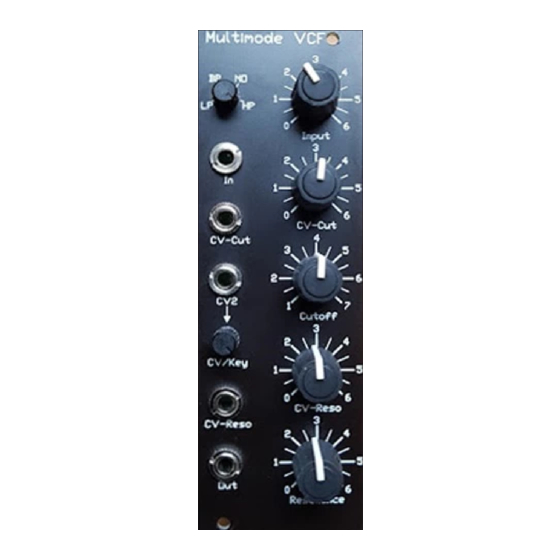
Advertisement
Table of Contents
General
The 12 dB multimodefilter offers four modes Low (LP)-, Band(BP)- and High-pass(HP) as
well as Band reject (NOTCH).You can switch in between all modes, using the LP-BP-NO-
HP-knob. Although this is a knob without lock-in position, there is NO crossfade in between
those four modes.
Setup
The 12 dB Multimode-filter is fully compatible to the Doepfer A-100 in Size and bus-power.
Connect the 16-Pin MFB-connector-cable to the corresponded 16-pin jack of the MIDI/CV-
Board or on the Doepfer-mainframe-bus. Supply Voltage needs to be +/- 12 Volt, 5-volt
connections are not required. The wattage is +/- 30 mA, the size of the module is 8 TE
(Teileinheiten)=40mm.
ATTENTION: Please check for the right polarty! The colored side of the connector-cable
needs to point downwards, so that the cable is not twisted.
Function
Operating principles of this Filter: An audio-signal of an oscillator (VCO), noise-generator
(NOISE) or any external Device is fed into the module through the audio-input. The Filter is
processing the signal via Cutoff. The more you close the Cutoff the less overtones will pass
the filter (low-pass). Band-pass filters high as well as low frequencies and high-pass filters
only high frequencies. Resonance defines the range of cutoff, which gives the typical analogue
filter sound, to it. Both parameters can be modulated by CV. The processed signal reaches the
audio-output, where it can be lead to another sound shaping module or to an attenuator(VCA).
Cutoff
The Cutoff-Frequency can be controlled manually and accessed over the CV-inputs.
Input CV1 is adjustable and is designated for standard modulation through an envelope. Input
CV2 has a double function: the internal Key-CV-Voltage is directly connected to the system-
bus (if fed in through a MIDI/CV-Interface or Bus Access-Module), which allows a direct
keyboard tracking of the Cutoff –frequency. Tracking-Intensity can be adjusted using the trim
controller CV2/Key. In addition you can use the input CV2 on the front side, to get another
CV-Voltage to control the Cutoff through an LFO, its intensity is also adjusted, using the trim
controller CV2/Key. The internal connection to the Key-CV of the system-bus, can be cut off,
to handle the second CV-Input independently, by putting a jumper on the circuit board.
Resonance
Resonance can be adjusted manually using the Resonance-controller, and can
be modulated via CV on the input CV Reso with its corresponding attenuator.
Around resonance-controller-position 6 (through component tolerance this may vary from
module to module) the filter reaches self-oscillation, in doing so the filter generates a sound
without receiving a signal on the audio-input. This sound is similar to a sinus its pitch is set by
the cutoff.
By controlling the cutoff via Key-CV the Filter in certain limits tonal playable, but is not as
precise controllable as an Oscillator.
Tip: with a self-oscillating filter you can create beautiful analogue percussion sounds. Cutoff
has to be modulated with a fast envelope (short decay, low sustain). For more timbre, mix a bit
Filter-FM(audio-frequency of a LFO or VCO) in. In almost all old analogue Drum-machines
corresponding sounds where made by self-oscillating filters instead of VCOs.
Advertisement
Table of Contents

Summary of Contents for MFB Multimode VCF
- Page 1 The 12 dB Multimode-filter is fully compatible to the Doepfer A-100 in Size and bus-power. Connect the 16-Pin MFB-connector-cable to the corresponded 16-pin jack of the MIDI/CV- Board or on the Doepfer-mainframe-bus. Supply Voltage needs to be +/- 12 Volt, 5-volt connections are not required.
- Page 2 User manual 12 dB Multimode VCF...


Need help?
Do you have a question about the Multimode VCF and is the answer not in the manual?
Questions and answers